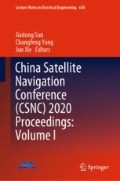Abstract
It is an important application of GNSS in marine remote sensing to measure sea level by using Global Navigation Satellite System Interferometry Reflectometry (GNSS-IR), which provides a new direction for global sea level change research. At present, the accuracy of sea level retrieved from GNSS single-frequency observations needs to be further improved. In order to solve this problem, this paper proposed a new retrieval method based on the peak weighting scheme of integrating the respective sea level retrieved from signal-to-noise ratio (SNR) data of two single frequency L1 and L2 of the Global Positioning System (GPS). The peak weighting method takes the peak power of the spectral analysis of the observed signal-to-noise ratio as the weight, thereby integrating dual-frequency data for sea level retrieval. In order to verify the validity of the mentioned method, the continuous multi-day dual-frequency SNR observation data of two coastal GPS stations were processed and analyzed. At first, the Lomb-Scargle Periodogram (LSP) spectral analysis method was used to obtain the peak oscillation frequency. Then the peak weighting method is used to fuse the two-frequency sea level retrieval results. At last, the sea level results obtained from the single-frequency observations are compared with that of the double-frequency observations, and the proposed weighting method is verified by comparing with tide gauge. The results show that the accuracy of the retrieval results using the peak weighting method is better than that of the GPS single-frequency observations when sea condition is good, while the accuracy improvement is not obvious when the sea surface is rough.
Access this chapter
Tax calculation will be finalised at checkout
Purchases are for personal use only
References
Zhang, S., Nan, Y., Li, Z., et al.: Analysis of tide variation monitored by GNSS-MR. Acta Geodaetica Cartogr. Sin. 45(9), 1042–1049 (2016)
Martin, M.: A passive reflectometry and interferometry system (PARIS): application to ocean altimetry. ESA J. 17, 331–355 (1993)
Anderson, K.D.: Determination of water level and tides using interferometric observations of GPS signals. J. Atmos. Oceanic Technol. 17(8), 1118–1127 (2000)
Bilich, A., Larson, K.M., Axerad, P.: Observations of signal-to-noise ratios (SNR) at geodetic GPS Site CASA: implications for phase multipath. Proc. Cent. Eur. Geodyn. Seismol. 23, 77–83 (2004)
Larson, K.M., Löfgren, J.S., Haas, R.: Coastal sea level measurements using a single geodetic GPS receiver. Adv. Space Res. 51, 1031–1310 (2013)
Löfgren, J.S., Haas, R., Scherneck, H.: Sea level time series and ocean tide analysis from multipath signals at five GPS sites in different parts of the world. J. Geodyn. 80, 66–80 (2014)
Strandberg, J., Hobiger, T., Haas, R.: Inverse modelling of GNSS multipath for sea level measurements—initial results. In: Proceedings of the 2016 IEEE International Geoscience and Remote Sensing Symposium (IGARSS), Beijing, China, 10–15 July 2016, pp. 1867–1869 (2016)
Jin, S., Qian, X., Wu, X.: Sea level change from BeiDou navigation satellite system-reflectometry (BDS-R): first results and evaluation. Glob. Planet. Change 149, 20–25 (2017)
Wang, N., Xu, T., Gao, F., Xu, G.: Sea level estimation based on GNSS dual-frequency carrier phase linear combinations and SNR. Remote Sens. 10, 470 (2018). https://doi.org/10.3390/rs10030470
Liu, L., Fend, H., Chen, W., et al.: Study on sea level height retrieval based on GPS signal-to-noise ratio. J. Guilin Univ. Technol. 37(4), 629–634 (2017)
Wu, J., Yang, R.: Using GPS receiver reflected signal to measure sea level. Geodesy Geodyn. 32(6), 135–138 (2012)
Sun, X., Zhang, S., Wu, J., et al.: Mechanism analysis of GPS-IR technology based on SNR. Adv. Earth Sci. 34(2), 156–163 (2019)
Li, Y., Chang, X., Yu, K., et al.: Estimation of snow depth using pseudorange and carrier phase observations of GNSS single-frequency signal. GPS Solut. 23, 118 (2019)
Acknowledgement
Thanks to the US Plate Boundary Observation (PBO) and International GNSS Service (IGS) for providing GPS observation data, and the US National Oceanic and Atmospheric Administration (NOAA) for providing tide gauge observation data. The study is funded by State Key Laboratory of Geo-information Engineering Program (SKLGIE2017-M-3-4) and National Natural Science Foundation of China (41704017, 41931076, 41874032, and 41731069).
Author information
Authors and Affiliations
Corresponding author
Editor information
Editors and Affiliations
Rights and permissions
Copyright information
© 2020 The Editor(s) (if applicable) and The Author(s), under exclusive license to Springer Nature Singapore Pte Ltd.
About this paper
Cite this paper
Wang, J., Xu, T., Wang, N., He, Y., Gao, F. (2020). Research on Sea Surface Height Measurement Based on GNSS-IR Dual Frequency Data Fusion. In: Sun, J., Yang, C., Xie, J. (eds) China Satellite Navigation Conference (CSNC) 2020 Proceedings: Volume I. CSNC 2020. Lecture Notes in Electrical Engineering, vol 650. Springer, Singapore. https://doi.org/10.1007/978-981-15-3707-3_15
Download citation
DOI: https://doi.org/10.1007/978-981-15-3707-3_15
Published:
Publisher Name: Springer, Singapore
Print ISBN: 978-981-15-3706-6
Online ISBN: 978-981-15-3707-3
eBook Packages: EngineeringEngineering (R0)

